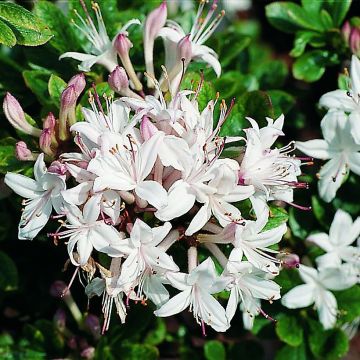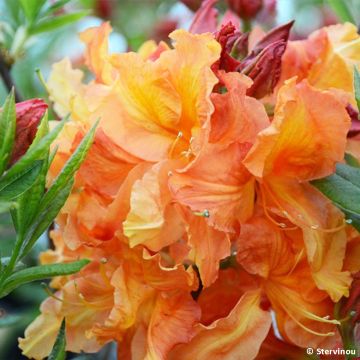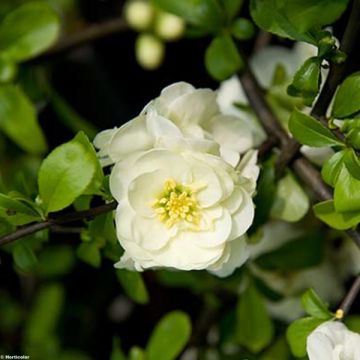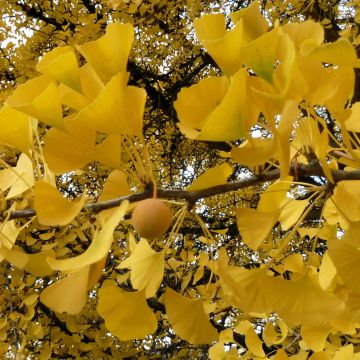

Rhododendron occidentale Delicatissima - Western Azalea
Rhododendron occidentale Delicatissima - Western Azalea
Rhododendron (Azalea) x occidentale Delicatissima
Western Azalea, Pacific Azalea, California Azalea
The bush arrived in good condition after 6 days of travel (Belgium). I have just planted it. We will see over time how it flourishes with us.
Claudine, 27/03/2024
This item cannot be shipped to the selected country
Delivery charge from €5.90
More information
Schedule delivery date,
and select date in basket
This plant carries a 24 months recovery warranty
More information
We guarantee the quality of our plants for a full growing cycle, and will replace at our expense any plant that fails to recover under normal climatic and planting conditions.
From €5.90 for pickup delivery and €6.90 for home delivery
Express home delivery from €8.90.

Does this plant fit my garden?
Set up your Plantfit profile →
Description
The Azalea 'Delicatissima' is part of a group of Chinese Azaleas hybrids with large remarkably fragrant pastel flowers inherited from their American ancestor, the Western Rhododendron. This bush is covered in spring with bouquets of large light pink flowers enhanced by beautiful yellow-orange macules and marbled with brown highlights, exhaling a very beautiful honeysuckle scent. At the end of the season, it is through the flamboyant colours of its foliage that this delightful azalea stands out. From its original regions, the coastal regions of the Pacific, it has retained a certain sensitivity to extreme cold. Too little known and used, deciduous azaleas are infinitely graceful plants that thrive in non-calcareous soil, endowed with many qualities, definitely worth discovering in the garden or in a large pot on the terrace!
The Western Rhododendron is a shrub belonging to the heather family Ericaceae, native to an area ranging from Oregon to southern California, and even to Mexico. This plant is also found at high altitudes in the mountains (hills or canyons) that border the west coast of the United States, often not far from watercourses, on deep and serpentine moist soil, known to be inhospitable for the vast majority of other plants: serpentinite is an ultra-basic rock resulting from volcanic activity, low in calcium and aluminum but rich in heavy elements such as chromium, nickel, and cobalt. The Western Azalea has the amazing ability to regenerate from the stump after fire or other natural disasters, as long as the root system remains intact. This surprising species, highly variable in nature, has produced some of the most fragrant deciduous azalea varieties through hybridization, especially the English Exbury hybrids.
'Delicatissima' is an old cultivar obtained in England. It is a rather slow-growing bush. It has a dense, ramified, slightly spreading, slender and bushy habit. At maturity, this azalea reaches about 1.20m (3ft 11in) in height with a spread of 1m (3ft 4in), sometimes up to 1.50m (4ft 11in) in height. Its remarkably fragrant flowering takes place from mid-May to mid-June depending on the climate, and lasts for a beautiful period, just before the appearance of the young leaves on the branches. The large flowers, measuring up to 6.5cm (2.6in) in diameter, have a funnel shape with undulating edges and are gathered in terminal clusters of up to 15 flowers. They emerge from pale pink buds and open into corollas of a tender pink washed with deeper pink and brown reflections, maculated with golden yellow to orange on the upper petal. The inner surface of the petals is shiny and sparkling, covered with a kind of iridescent dust. They are adorned with 5 long arched stamens that contribute to the beauty of the flowers. The deciduous foliage is composed of simple, ovate-lanceolate, entire-edged leaves arranged alternately on the branches. Their size ranges from 5 to 10 centimetres (2 to 3.9 inches) in length, and their summer colour is a vibrant green that turns flamboyant shades in October. Rhododendrons have a shallow root system that should never lack moisture, but they fear stagnant humidity that suffocates them.
Deciduous Chinese azaleas have less requirements than evergreen Japanese azaleas: they are very hardy and tolerate sunny exposures, and even occasionally dry soil depending on the hybrids. Nevertheless, they give their best in cool climates with marked winters, planted in humus-rich and fertile soil, devoid of active limestone. They are very beautiful shrubs for borders, with a very natural habit, and they are attractive twice a year. They happily accompany Japanese maples, which also change their appearance with the seasons. They can also be associated with Japanese camellias or their graceful and often fragrant autumn-flowering cousins, the hybrids of C.sasanqua. They can also be grown in a carefully chosen large pot, in a suitable substrate, and watered with non-calcareous water if possible. The undeniable beauty of deciduous azaleas deserves some adjustments to recreate the conditions they prefer.
A fragrant note:
The heady fragrance of the Western Azalea is capable of perfuming an entire canyon in its natural environment. Particularly noticeable in hot weather, it evokes, according to some observers, the spicy fragrance found in carnations, with a hint of cloves.
Report an error about the product description
Rhododendron occidentale Delicatissima - Western Azalea in pictures




Plant habit
Flowering
Foliage
Botanical data
Rhododendron (Azalea)
x occidentale
Delicatissima
Ericaceae
Western Azalea, Pacific Azalea, California Azalea
Cultivar or hybrid
Other Chinese Azalea
Planting and care
The Western Azalea 'Delicatissima' appreciates a sunny location unlike the Japanese Azalea, but its preferred exposure is partial shade, or morning sun, to the east, especially in our very sunny and hot regions. Plant it in a soil of heather, or humus, moist but well-drained, but above all not calcareous. Choose a sheltered location from cold and dry winds: the plant is hardy up to -15°C (5 °F) for short periods in healthy soil and in a sheltered position. During planting, make sure not to bury the root ball too deep, it should be at ground level. Water abundantly during dry periods, at least once a week in the first year. In spring, apply fertilizer for heather plants. After flowering, do a light pruning to keep the plant tidy, even if pruning is not essential. Remove faded flowers to encourage the appearance of new shoots. The Azalea has few diseases when well established outdoors. It can be attacked by weevils that eat the edge of the leaves and rootlets, as well as by the famous "rhododendron beetle" which rarely causes significant damage. If that's the case, treat with carbofuran. If the soil is calcareous or poorly drained, and if the plant is planted too deeply, the leaves may turn yellow.
Some cultivars are quite sensitive to powdery mildew in overly humid or dry atmospheres.
Planting period
Intended location
Care
-
, onOrder confirmed
Reply from on Promesse de fleurs
Spring-flowering shrubs
Haven't found what you were looking for?
Hardiness is the lowest winter temperature a plant can endure without suffering serious damage or even dying. However, hardiness is affected by location (a sheltered area, such as a patio), protection (winter cover) and soil type (hardiness is improved by well-drained soil).

Photo Sharing Terms & Conditions
In order to encourage gardeners to interact and share their experiences, Promesse de fleurs offers various media enabling content to be uploaded onto its Site - in particular via the ‘Photo sharing’ module.
The User agrees to refrain from:
- Posting any content that is illegal, prejudicial, insulting, racist, inciteful to hatred, revisionist, contrary to public decency, that infringes on privacy or on the privacy rights of third parties, in particular the publicity rights of persons and goods, intellectual property rights, or the right to privacy.
- Submitting content on behalf of a third party;
- Impersonate the identity of a third party and/or publish any personal information about a third party;
In general, the User undertakes to refrain from any unethical behaviour.
All Content (in particular text, comments, files, images, photos, videos, creative works, etc.), which may be subject to property or intellectual property rights, image or other private rights, shall remain the property of the User, subject to the limited rights granted by the terms of the licence granted by Promesse de fleurs as stated below. Users are at liberty to publish or not to publish such Content on the Site, notably via the ‘Photo Sharing’ facility, and accept that this Content shall be made public and freely accessible, notably on the Internet.
Users further acknowledge, undertake to have ,and guarantee that they hold all necessary rights and permissions to publish such material on the Site, in particular with regard to the legislation in force pertaining to any privacy, property, intellectual property, image, or contractual rights, or rights of any other nature. By publishing such Content on the Site, Users acknowledge accepting full liability as publishers of the Content within the meaning of the law, and grant Promesse de fleurs, free of charge, an inclusive, worldwide licence for the said Content for the entire duration of its publication, including all reproduction, representation, up/downloading, displaying, performing, transmission, and storage rights.
Users also grant permission for their name to be linked to the Content and accept that this link may not always be made available.
By engaging in posting material, Users consent to their Content becoming automatically accessible on the Internet, in particular on other sites and/or blogs and/or web pages of the Promesse de fleurs site, including in particular social pages and the Promesse de fleurs catalogue.
Users may secure the removal of entrusted content free of charge by issuing a simple request via our contact form.
The flowering period indicated on our website applies to countries and regions located in USDA zone 8 (France, the United Kingdom, Ireland, the Netherlands, etc.)
It will vary according to where you live:
- In zones 9 to 10 (Italy, Spain, Greece, etc.), flowering will occur about 2 to 4 weeks earlier.
- In zones 6 to 7 (Germany, Poland, Slovenia, and lower mountainous regions), flowering will be delayed by 2 to 3 weeks.
- In zone 5 (Central Europe, Scandinavia), blooming will be delayed by 3 to 5 weeks.
In temperate climates, pruning of spring-flowering shrubs (forsythia, spireas, etc.) should be done just after flowering.
Pruning of summer-flowering shrubs (Indian Lilac, Perovskia, etc.) can be done in winter or spring.
In cold regions as well as with frost-sensitive plants, avoid pruning too early when severe frosts may still occur.
The planting period indicated on our website applies to countries and regions located in USDA zone 8 (France, United Kingdom, Ireland, Netherlands).
It will vary according to where you live:
- In Mediterranean zones (Marseille, Madrid, Milan, etc.), autumn and winter are the best planting periods.
- In continental zones (Strasbourg, Munich, Vienna, etc.), delay planting by 2 to 3 weeks in spring and bring it forward by 2 to 4 weeks in autumn.
- In mountainous regions (the Alps, Pyrenees, Carpathians, etc.), it is best to plant in late spring (May-June) or late summer (August-September).
The harvesting period indicated on our website applies to countries and regions in USDA zone 8 (France, England, Ireland, the Netherlands).
In colder areas (Scandinavia, Poland, Austria...) fruit and vegetable harvests are likely to be delayed by 3-4 weeks.
In warmer areas (Italy, Spain, Greece, etc.), harvesting will probably take place earlier, depending on weather conditions.
The sowing periods indicated on our website apply to countries and regions within USDA Zone 8 (France, UK, Ireland, Netherlands).
In colder areas (Scandinavia, Poland, Austria...), delay any outdoor sowing by 3-4 weeks, or sow under glass.
In warmer climes (Italy, Spain, Greece, etc.), bring outdoor sowing forward by a few weeks.






















































